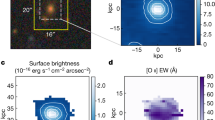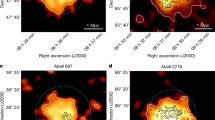Abstract
MANY clusters of galaxies from Abell's catalogue1 have recently been observed at 1,400 MHz with the 300-foot radio telescope of the NRAO (ref. 2 and F. Owen, to be published). On the Palomar Sky Survey prints we inspected 355 clusters of galaxies (111 of them were observed by H.M.T.2, the remaining 244 by F. Owen, to be published) which belong to distance group 5 and thus are situated at almost the same distance. Radio emission in excess of 0.1 flux units (f.u.) was detected from 95 out of the 355. A radio source was identified with a cluster of galaxies if it was within 5 arc min from the cluster centre, the diameter of which is about 25 arc min.
This is a preview of subscription content, access via your institution
Access options
Subscribe to this journal
Receive 51 print issues and online access
$199.00 per year
only $3.90 per issue
Buy this article
- Purchase on SpringerLink
- Instant access to full article PDF
Prices may be subject to local taxes which are calculated during checkout
Similar content being viewed by others
References
Abell, G. O., Astrophys. J. suppl., 3, 211 (1958).
Tovmassian, H. M., Astrofisika, 9, 177 (1973).
Bautz, L. P., and Morgan, W. W., Astrophys. J., 162, L149 (1970).
Author information
Authors and Affiliations
Rights and permissions
About this article
Cite this article
TOVMASSIAN, H., SHIRBAKIAN, M. How long do radio galaxies emit at radio wavelengths. Nature 250, 474 (1974). https://doi.org/10.1038/250474a0
Received:
Revised:
Issue date:
DOI: https://doi.org/10.1038/250474a0
This article is cited by
-
cD galaxies of apparent supergiant sizes due to the curvature of space
Astrophysics and Space Science (1986)



